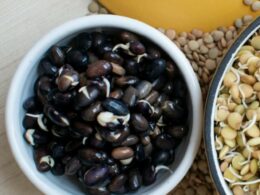In This Article Show
We’re shedding light on a question that often sprouts up in the minds of both novice and seasoned gardeners alike: Do sprouts need sunlight? As someone who has nurtured gardens for over 13 years, I understand the importance of demystifying such queries to ensure successful plant cultivation.
Before we delve into the specifics, let’s clarify what we mean by “sprouts.” These tiny powerhouses of nutrition are the young, tender shoots that emerge from seeds during the germination process.
From the ubiquitous bean sprouts to the nutrient-rich broccoli sprouts and delicate alfalfa sprouts, these miniature greens pack a punch when it comes to health benefits.
Now, we all know that sunlight plays a pivotal role in the growth of plants, driving the process of photosynthesis that produces the energy necessary for their development. But do these miniature wonders of nature follow the same rule? Can sprouts thrive without basking in the sun’s rays?
Do Sprouts Need Sunlight?
Yes, sprouts need sunlight to thrive. Sunlight is crucial for photosynthesis, which provides sprouts with the energy they need to grow and develop. Without adequate sunlight, sprouts may struggle to reach their full potential and may lack essential nutrients. Therefore, it’s important to ensure that sprouts receive sufficient sunlight or alternative light sources to support their growth.
Get Gardening For Beginners
Our new EBOOK shows newcomers and green thumbs alike a step by step guide to growing the garden of their dreams.
Do Sprouts Need Sunlight?

Overview of the Germination Process in Sprouts
Before we delve into the sunlight requirements of sprouts, let’s first understand the germination process. Sprouting is the initial stage of a plant’s life cycle, where a seed begins to grow and develop into a young plant. During germination, the seed absorbs water, swells, and activates enzymes that initiate metabolic processes, leading to the emergence of a tiny shoot.
This shoot, also known as the sprout, contains all the essential nutrients required for the young plant’s growth. As the sprout continues to develop, it relies on these stored nutrients until it can establish its root system and begin photosynthesis.
Contrasting the Needs of Sprouts with Mature Plants Regarding Sunlight
While mature plants rely heavily on sunlight for photosynthesis – the process by which they convert light energy into chemical energy to fuel growth – the requirements of sprouts are slightly different. Unlike mature plants with developed leaves and extensive root systems, sprouts are in their infancy and have unique needs.
During germination, sprouts primarily depend on the energy stored within the seed for growth. They do not yet have fully developed leaves or an established root system to absorb nutrients from the soil. As a result, their reliance on sunlight is minimal during this early stage.
However, once sprouts begin to develop leaves and roots, their need for sunlight increases. Exposure to sunlight triggers photosynthesis, allowing the sprout to produce its food and continue growing into a healthy plant.
While sprouts can tolerate low light conditions during germination, providing adequate sunlight at this stage can promote faster and healthier growth.
Experimental Evidence and Research Findings
Several studies have investigated the effects of light on sprout growth and development. One study published in the Journal of Experimental Botany found that exposure to red and blue light wavelengths significantly increased the growth rate of broccoli sprouts compared to those grown in darkness.
Get Gardening For Beginners
Our new EBOOK shows newcomers and green thumbs alike a step by step guide to growing the garden of their dreams.
This suggests that certain light wavelengths play a crucial role in stimulating sprout growth.
Furthermore, research conducted at various agricultural universities has shown that providing sufficient sunlight to sprouts can enhance their nutritional content. Sunlight stimulates the production of chlorophyll and other phytonutrients in sprouts, making them richer in vitamins, minerals, and antioxidants.
In conclusion, while sprouts do not require sunlight during the initial stages of germination, adequate light exposure becomes increasingly important as they develop into young plants. Providing sunlight to sprouts can promote faster growth, enhance nutritional content, and ultimately lead to healthier and more robust plants.
Factors Influencing Sprout Growth
Light Requirements for Different Types of Sprouts
The light requirements for sprouts can vary depending on the type of plant species. Some sprouts, such as alfalfa and clover, are considered “low-light” sprouts and can thrive in indirect sunlight or even partial shade. These types of sprouts are well-suited for indoor growing environments where direct sunlight may be limited.
On the other hand, certain sprouts, like sunflower and wheatgrass, are considered “high-light” sprouts and require more direct sunlight to grow optimally. These sprouts benefit from being placed in a sunny spot outdoors or under grow lights indoors to ensure they receive sufficient light for photosynthesis.
Understanding the specific light requirements of different types of sprouts is essential for providing optimal growing conditions and maximizing their growth potential.

Indoor vs. Outdoor Sprouting
Indoor Sprouting
| PROS | CONS |
|---|---|
| Control over environmental factors such as temperature, humidity, and light exposure. | Limited access to natural sunlight, which may require supplemental grow lights to ensure adequate light exposure for certain types of sprouts. |
| Suitable for year-round sprouting, regardless of outdoor weather conditions. | Increased risk of mold or fungal growth in indoor environments with poor ventilation or excessive humidity. |
| Ideal for individuals with limited outdoor space or urban dwellers without access to a garden. | Requires regular monitoring and maintenance to prevent issues such as overwatering or nutrient deficiencies. |
Outdoor Sprouting
| PROS | CONS |
|---|---|
| Abundant access to natural sunlight, which is essential for photosynthesis and promoting healthy growth. | Vulnerable to pest infestations and wildlife interference, especially without proper protection measures such as netting or row covers. |
| Minimal need for artificial lighting or supplemental heating, reducing energy costs. | Dependent on weather conditions and seasonal changes, limiting the ability to sprout certain varieties year-round. |
| Reduced risk of mold or fungal growth due to better air circulation and natural ventilation. | May require more space and effort for soil preparation, watering, and pest management compared to indoor sprouting setups. |
Ultimately, the decision between indoor and outdoor sprouting depends on factors such as available space, climate, and personal preferences. Both methods offer unique advantages and challenges, and experimenting with different growing techniques can help determine the most suitable approach for your specific needs and circumstances.










